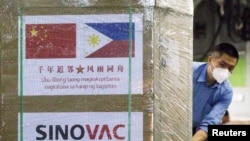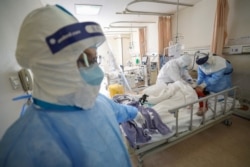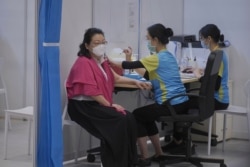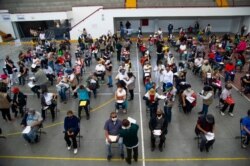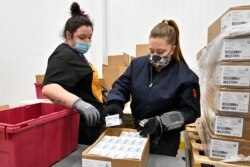Experts say that skepticism about Chinese vaccines in developing nations may counter Beijing’s goal of increasing its influence by distributing doses.
China approved the first batch of domestically produced COVID-19 vaccines last December without publishing clinical trial data. By February 2021, China had exported or was in the process of exporting Sinopharm and Sinovac vaccines to 22 countries and will provide vaccine aid to 53 developing countries including Pakistan, according to Chinese Foreign Ministry spokesperson Wang Wenbin.
The coronavirus that causes the COVID-19 disease was first detected in humans in the Chinese city of Wuhan in late 2019. Spreading from there, it continues to ravage the globe. According to the Johns Hopkins Coronavirus Resource Center, more than 123.2 million people worldwide currently have been sickened and more than 2.7 million people have died.
Although China has largely contained the outbreak in its population with strict and pervasive social controls and vaccinations, in January, YouGov, a British market research firm, surveyed about 19,000 people in 17 countries and territories and found that Chinese-made vaccines were perceived negatively, scoring above only one made in Iran.
China denies that it is using the coveted vaccine as a diplomatic tool, one that Chinese President Xi Jinping has said will be used for global good. "China has promoted cooperation in the fight against the pandemic but never pursued any geopolitical objectives, nor calculated any economic benefits or attached any political conditions," the state-run news agency Xinhua wrote in a signed opinion article.
News reports say none of China’s vaccines has been approved by the World Health Organization.
Vuk Vuksanovic, researcher at the London School of Economics (LSE) and the Belgrade Center for Security Policy, said that it is appropriate to use "vaccine diplomacy" to characterize China's vaccine policy, which is a continuation of China's "mask diplomacy" aimed at shaping China as a responsible player able to lessen global shortages of critical items during the pandemic.
Vuksanovic told VOA, “The (vaccine) policy is about repairing the reputational damage caused to China by the initial outbreak, increasing Chinese political influence with individual countries, building China's global soft power capital, and trying to win a share of the global vaccination market in competition with Western and Russian vaccine manufacturers.”
China has linked vaccine exports to global strategic objectives. The "Health Silk Road" has become an important part of the initiative with Chinese health officials publicly calling for providing vaccines to Belt and Road countries first, as a counterweight to the Belt and Road Initiative (BRI). Sometimes referred to as the New Silk Road, the BRI is one of the most ambitious infrastructure projects the world has ever seen. Xi launched it in 2013 with a vision of Chinese investment and development projects expanding China’s global influence.
Daniel Aldrich, director of the security and resilience studies program at Northeastern University in Boston, told VOA Mandarin that “China has not offered vaccines to South Korea, Japan, or other neighboring countries; instead, it has focused on projecting its soft power abroad to developing nations where it hopes to create a favorable reputation and build a network of allies.”
In the summer of 2020, China began offering vaccine assistance to Middle Eastern, Latin American and African countries, promoting opportunities for local trade and investment.
Martha Delgado, Mexico's deputy foreign minister, said on March 15 Mexico would remember the assistance from China.
China also sees gaining international recognition for its vaccines as a way to raise the profile of its medical products. Before the coronavirus pandemic, Chinese pharmaceutical companies rarely qualified to provide medical products to international agencies. In 2019, China accounted for only 1.9% of the total purchases of medical products made by the United Nations while rival India accounted for 21.9%.
Beijing also plans to ease restrictions on entry for foreigners who have been vaccinated against COVID-19 with formulations made in China.
Nicholas Thomas, associate professor in health security at the City University of Hong Kong told VOA, “This incentive that is clearly targeted at the business community, in particular, and is one way that China can help to ensure that its vaccine remains the preferred choice --- and clearly shows how much these efforts are focused on the diplomatic element as much as the provision of a medical public good.”
China's export advantage in vaccines initially was due to a lack of competition from Western countries. But on March 12, Australia, India, Japan and the United States agreed at the Quadrilateral Security Dialogue (QUAD) to provide 100 million doses of the vaccine developed by Johnson & Johnson in the United States to most of Asia by the end of 2022 to counter China's influence in the Indo-Pacific region.
“Now with the QUAD deal, that dominance is no longer assured. It will be interesting to see the choice regional populations make between Chinese and the J&J vaccine,” said Thomas in an email. “The choice will be a clear indication as to how much the region’s people and not just their governments trust the Chinese option.”
Aldrich said the QUAD members “are all countries that see evidence of aggressive expansionism and revisionism by China. This effort from the QUAD, in an attempt to contain China’s soft power influence, will definitely produce more vaccinations for the world.”
Vaccines from Sinovac Biotech, Sinopharm and Johnson & Johnson can be stored at 2- to 8°C (36°F to 46°F). This solves the problem of storage conditions in many developing countries because other vaccines need ultra-low conditions — -80 degrees C to -15°C (-112°F to 5°F) — to remain effective.
China's vaccines require two injections, and the Johnson & Johnson vaccine requires only one shot, meaning the latter can be used to immunize a target population more quickly.
Further complicating China’s push is a plan by the World Health Organization (WHO). In cooperation with two other vaccine promotion groups, WHO launched COVAX, which began administering vaccines in Africa on March 1 with the goal of distributing at least 2 billion doses by the end of 2021 in poor and middle-income countries.
Adrianna Zhang contributed to this story.




